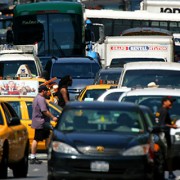Traffic Congestion Jumps as U.S. Economy Rebounds
KIRKLAND, Wash., April 1, 2013 /PRNewswire/ — Gridlock in the U.S. has staged a dramatic comeback after two years of post-recession lows. Data from the most recent INRIX Gridlock Index (IGI) shows that traffic jumped by almost 10 percent during February – the largest year-over-year increase recorded by IGI in two years, and a healthy sign of rising economic activity across 100 metro areas.
“Traffic is a great indicator of confidence on the ground,” said Bryan Mistele, CEO of INRIX. “People hit the road as they return to work, and businesses ship more freight as their orders increase. IGI shows the pulse of the economy is starting to beat faster.”
February’s composite IGI score of 6.8 meant that the average trip took drivers in the 100 most populated metro areas 6.8 percent longer because of increased traffic congestion. The IGI’s positive turn was echoed by a recent report on the U.S. housing sector. The U.S. Commerce Department reported thatFebruary 2013 permits for future construction rose 4.6 percent, reaching the highest level since June 2008.[1]
The dramatic shift seen in the top-line trend was mirrored by significant jumps in traffic congestion in many of the nation’s largest metro areas. For example:
- Gridlock in Chicago increased over 20 percent from February 2012 to February 2013, hinting that the metro area’s slow recovery[2] may be gathering speed.
- Gridlock in Phoenix increased by almost 19 percent from February 2012 to February 2013, confirming recent decisions made by several retail and casual dining chains to expand in the metro area. [3]
- Gridlock in New York increased by almost 18 percent from February 2012 to February 2013. This jump is in line with recent news of strong private sector job growth [4].
- Traffic congestion in Houston increased over 10 percent from February 2012 to February 2013, confirming University of Houston Economics Professor Barton Smith’s claim of a recent “boom” in the metro area. [5]
Bucking these trends were San Antonio and San Diego. From February 2012 to February 2013 these metro areas saw traffic decrease by 24 percent and 18 percent, respectively, providing an indication of the impact defense spending cuts that went into effect in March could have on the local economy[6].









